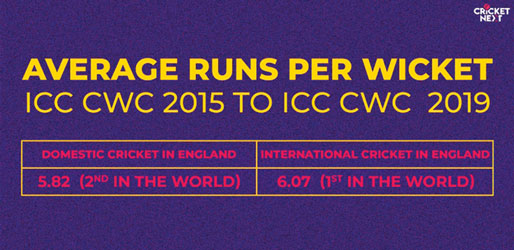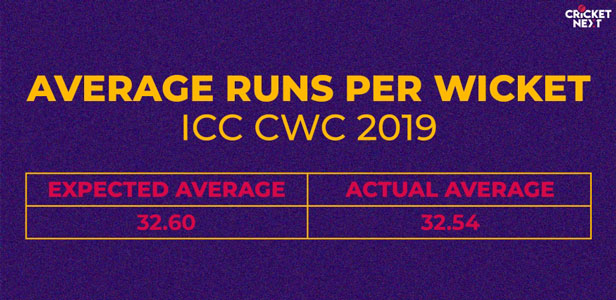Perhaps the most significant trend to emerge from the World Cup so far has been the surprising nature of contests relative to recent years in England, reports https://www.news18.com.
In this World Cup cycle ODIs in England have been dominated by batsmen to an extraordinary degree. Part of the reason for this was the brilliance of England's batting, which carried them to the top of the world rankings in advance of the tournament.
 Another reason was a directive from the ECB to their groundsmen to produce flatter pitches, more conducive to the high-scoring, power-orientated game that they wanted their team to adopt. The results were clear to see: at international level, no host country had a higher average run rate in this World Cup cycle than England and at domestic level only Pakistan saw faster scoring rates. However, in this World Cup this trend has not continued. Rather than the run-fest that was expected, this World Cup has instead been defined by lower-scoring scraps. There have been occasional huge totals: England have twice scaled 375 against Afghanistan and Bangladesh, Australia posted 381 against the West Indies and India plundered 351 against Australia. However, on the whole games have been lower scoring and the overall run rate of 5.54 runs per over has been significantly below what was expected.
Another reason was a directive from the ECB to their groundsmen to produce flatter pitches, more conducive to the high-scoring, power-orientated game that they wanted their team to adopt. The results were clear to see: at international level, no host country had a higher average run rate in this World Cup cycle than England and at domestic level only Pakistan saw faster scoring rates. However, in this World Cup this trend has not continued. Rather than the run-fest that was expected, this World Cup has instead been defined by lower-scoring scraps. There have been occasional huge totals: England have twice scaled 375 against Afghanistan and Bangladesh, Australia posted 381 against the West Indies and India plundered 351 against Australia. However, on the whole games have been lower scoring and the overall run rate of 5.54 runs per over has been significantly below what was expected.
The struggle of the batsmen is not only reflected in falling run rates but it is also evident in CricViz, a sports online portal, shot connection analysis. CricViz's Timing Rating - which considers the quality of connection made given the shot that was played and the bowler-type - shows that this World Cup has the second lowest Timing Rating of any series in England since the 2015 World Cup and is significantly lower than the figures seen in recent series.
Of course, one major reason for the drop off in the dominance of bat over ball is the simply the fact that England's powerful batting order haven't been playing in every match as they typically do in bilateral ODIs in the country.
 Rather than England competing against other teams, this World Cup sees a mixture of teams competing in unfamiliar conditions and the only team higher than England in the rankings is India. However, as demonstrated by England's failure to chase 233 against Sri Lanka and 286 against Australia, they too have struggled to replicate their normal game as effectively, suggesting a deeper issue at play than simply the teams on the field. There are a number of other possible explanations for the demise of batting predominance. One of them is 'tournament pressure' - a reason given by Indian captain Virat Kohli in advance of the competition for him expecting to see lower scores.
Rather than England competing against other teams, this World Cup sees a mixture of teams competing in unfamiliar conditions and the only team higher than England in the rankings is India. However, as demonstrated by England's failure to chase 233 against Sri Lanka and 286 against Australia, they too have struggled to replicate their normal game as effectively, suggesting a deeper issue at play than simply the teams on the field. There are a number of other possible explanations for the demise of batting predominance. One of them is 'tournament pressure' - a reason given by Indian captain Virat Kohli in advance of the competition for him expecting to see lower scores.
However, while this may indeed be a factor, 'pressure' is not something easily quantified - if indeed it exists at all, and if it does then it arguably effects bowlers as much as batsmen.
These unusual pitches might be explained by the ICC's control of pitch preparation, or - a more likely reason is the trouble caused by very poor weather in June - one of the wettest UK summer months on record.
Pitches appear to be one factor and tournament pressure might be another. Using CricViz's Expected Runs and Wickets model we are able to evaluate the quality of the bowling using ball tracking and assess whether the batsmen have over or under-performed relative to the balls they have faced.
The outputs of the model for the first 38 matches of the tournament suggest that batsmen in this tournament has performed almost exactly as we would expect based on the quality of bowling. In other words, the lower scoring rates are not the product of bad batting.
However, a comparison of the Expected Bowling Average in the World Cup and previous series in England since 2015 allows to evaluate whether the bowling has been notably better in this tournament than in previous series in the country. This comparison shows that, although not dramatically, the bowling in the World Cup has indeed been excellent. No series or tournament in England since 2015 has had a lower Expected Bowling Average than this World Cup.
As is often the case with issues such as these, the fact that this World Cup is lower scoring than expected appears to be the product of a number of factors rather than one clearly decisive one.